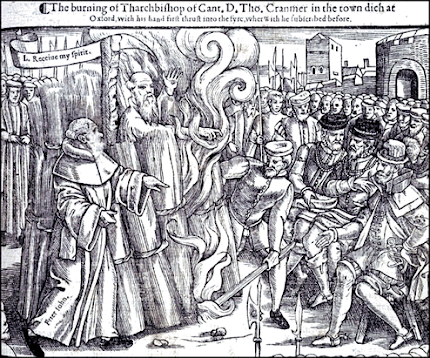- 10. Into what two great parties has the Protestant world always been divided?
- The whole Protestant world from the time of the Reformation has been divided into two great families of churches classified severally as LUTHERAN, or those whose character was derived from Luther and Melanchthon; and as reformed or those who have received the characteristic impress of Calvin. The LUTHERAN family of churches comprises all of those Protestants of Germany, of Hungary, and the Baltic provinces of Russia, who adhere to the Augsburg confession, together with the national churches of Denmark and of Norway and Sweden, and the large denomination of the name in America. These are estimated as amounting to a population of about twenty-five million pure Lutherans, while the Evangelical Church of Prussia, which was formed of a political union of the adherents of the two confessions, embraces probably eleven-and-a-half million. Their Symbolical Books are the Augsburg Confession and Apology, the Articles of Smalcald, Luther's Larger and Smaller Catechism, and, as received by the Stricter party, the Formula Concordiae. The CALVINISTIC or REFORMED churches embrace, in the strict usage of the term, all those Protestant Churches which derive their Theology from Geneva; and among these, because of obvious qualifying conditions, the Episcopal Churches of England, Ireland, and America form a subdivision by themselves; and the Wesleyan Methodists, who are usually classed among the Reformed because they were historically developed from that stock, are even yet more distinctly than the parent church of England removed from the normal type of the general class. In a general sense, however, this class comprises all those churches of Germany which subscribe to the Heidelburg Catechism, the churches of Switzerland, France, Holland, England, and Scotland, the Independents and Baptists of England and America, and the various branches of the Presbyterian Church in England, Ireland, and America. These embrace about eight million German Reformed in the Reformed church of Hungary; twelve million and a half Episcopalians; Presbyterians six million; Methodists, three million and a half; Baptists, four million and a half; and independents' one million and a half;--in all about thirty-eight millions.
- The principal confessions of the Reformed Church are the Gallic, Belgic, 2d Helvetic, and Scotch Confessions; the Heidelburg Catechism; the Thirty-nine Articles of the Church of England; the Canons of the Synod of Dort, and the Confession and Catechisms of the Westminster Assembly.
- http://www.graceonlinelibrary.org/articles/full.asp?ID=67%7C67%7C605
A.A. Hodge calls the Thirty-Nine Articles of Religion a "principle confession" of the Reformed Church. But earlier in the presentation he says that the Church of England and the Episcopal and Wesleyan churches that are indebted to it are not strictly "Reformed" in the Calvinist sense. I think Hodge is ambiguous on this point. Though a staunch Arminian himself, Wesley was highly influenced by the Moravians, a decidedly Calvinist group. Additionally, I might mention that Wesley was influenced by George Whitefield, the father of the Calvinist side of the Methodists. But in general no one can deny that the Book of Common Prayer and the Thirty-Nine Articles of Religion are Calvinist in tone and purpose. So it is clear to me that Anglicanism, despite many defections, belongs to the Calvinistic side of the Reformation and ought to be restored to that insofaras it is possible through reform and restoration from within.
As an aside, we should also note that semi-pelagianism is the position of the Eastern Orthodox churches according to Hodge:
- 6. What was the origin of the Middle or Semipelagian system? In the meantime, while the Pelagian controversy was at its height, John Cassian, of Syrian extraction and educated in the Eastern Church, having removed to Marseilles, in France, for the purpose of advancing the interests of monkery in that region, began to give publicity to a scheme of doctrine occupying a middle position between the systems of Augustine and Pelagius. This system, whose advocates were called Massilians from the residence of their chief, and afterward Semipelagians by the Schoolmen, is in its essential principles one with that system which is now denominated Arminianism, a statement of which will be given in a subsequent part of this chapter. Faustus, bishop of Priez, in France, from A. D. 427 to A. D. 480, was one of the most distinguished and successful advocates of this doctrine, which was permanently accepted by the Eastern Church, and for a time was widely disseminated throughout the Western also, until it was condemned by the synods of Orange and Valence, A. D. 529.
- http://www.graceonlinelibrary.org/articles/full.asp?ID=67%7C67%7C605
Moreover, I think Hodge oversimplifies the Wesleyan and and Methodist and Anglican churches because he does not particularize and specify their connection with Arminianism and thus with semi-pelagianism. In the strictest sense, Methodists are not Reformed since they adhere to Arminianism and are linked indirectly to semi-pelagianism.
Additionally, I am appreciative of the Augustinianism of Roman Catholic theologians like Thomas Aquinas but the prevalence of semi-pelagianism in their communion makes that almost irrelevant. It seems to me that the visible church is divided internally and externally and that the only hope for unity lies with the restoration of the biblical doctrine of justification by faith alone as the Gospel message.
A.A. Hodge's Outlines of Theology, though sometimes cumbersome reading, is a succinct and accurate summary of the Reformed faith in a systematic form. I highly recommend it to every Reformed and Anglican believer. I read somewhere that Charles Spurgeon required every ministry candidate to master Hodge's Outlines, even though he disagreed with the Presbyterian view concerning paedo or infant baptism.




No comments:
Post a Comment